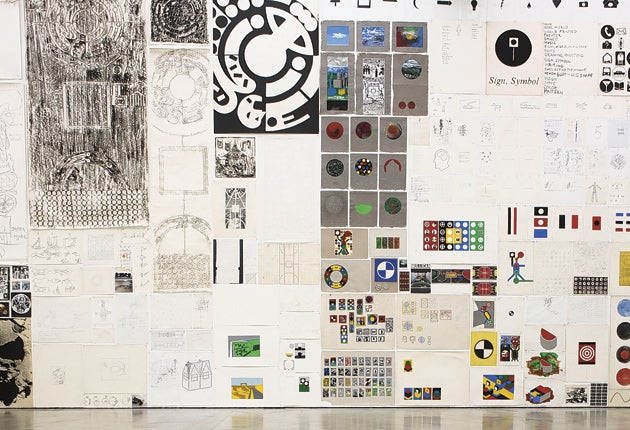For the blind man in the dark room looking for the black cat that isn't there, Institute of Contemporary Arts, London
This is the ICA at its best – a scattergun show that's funny, clever and impressive in its incoherence. See it if you can; if nothing else, it will make you think

As Yuletide images go, one from Peter Fischli and David Weiss's 1983 video, The Right Way, is memorable if not wholesome.
The Swiss duo, dressed, for reasons best known to themselves, as a bear and a rat, wander the Bernese Oberland meditating on metaphysics and the existence of natural evil. At one point, the rat – Fischli, or was it Weiss? – stops to puke on an edelweiss. "There," he says, contentedly, "now I feel better"; then, stirring through the proceeds with a stick, adds: "It was the mushrooms." Remember this, dear reader, on Christmas afternoon.
Actually, Fischli and Weiss's pavement pizza is noteworthy in other ways as well. It is part of a little vomit of a show, made up of variously digested bits and pieces through which the viewer is asked gently to pick. I do not mean this nastily. The whole point of the exhibition in question – called For the blind man in the dark room looking for the black cat that isn't there, at the Institute of Contemporary Arts – is that it requires analysis, organisation. It is made up of many parts (another, equivalent show runs concurrently at the Contemporary Art Museum in St Louis), ranging from the facsimile of a 1917 magazine by Marcel Duchamp and a pair of Morandi etchings from the 1920s to work made, in a spectrum of mediums, within the past year. Both the show itself and the objects in it call on us to impose a structure of our own; to stir through the evidence put in front of us and analyse it accordingly.
This fascination with order might seem an end-of-the-Noughties thing – Crisis of Faith Hits Art World! – except, as I say, that the works in For the blind man date from across the last century. I suppose it is arguable that art has always been concerned with Gestalt, with the arranging of the many into a single, greater whole. Morandi's endlessly reconfigured pots and jugs are an obvious case in point, as are the bits and bobs on Benoît Maire and Falke Pisano's Organon, an installation in the ICA's lower galleries. A bigger question, though, is whether the similarity between these seemingly disparate works is worth pointing out, and if so, why now?
It being Christmas, I'm going to leave you to sort out these answers for yourselves. What I will say for the ICA's show is that it is impressively coherent in its incoherence, that its scattergun approach does provoke one to muse. Much of the work in For the blind man is funny or clever or both. An example of the last is the interview on aesthetics conducted by the Belgian Surrealist Marcel Broodthaers in 1970 and relayed over speakers on the staircase to the ICA's upper floor – a normal enough thing for an art gallery, you might think, except that Broodthaers' interlocutor is his cat. Thus:
MB: "Is this work what you would expect from the recent move away from Conceptual Art towards a new kind of figuration?"
C: "Miaow."
MB: "After all, it is still all about the art market"
C: Miiaw ... mm ... miauw ... miauw."
and so on.
In the same vein, Bruno Munari's slideshow of photographs from the 1950s plays around with ideas of taxonomy, with cataloguing and ordering every permutation of a thing that, in the end, turns out to be pointless. The game is given away by the work's title, Looking for comfort in an uncomfortable chair. The Italian polymath, now unfairly forgotten, had himself photographed in black and white, wearing natty co-respondent shoes and rearranging himself in every imaginable posture – sideways on, upside down – in an old-fashioned plush armchair. The results, projected on to a small, white cube on the ICA's floor, look oddly scholarly, as though they were meant as illustrations to a Bauhaus treatise on furniture design. Actually, they are simple caprice, all order and no meaning. Equally, Hans-Peter Feldmann's sweet mini-photographs of a pound of strawberries – one for each of the 34 berries that made up his particular punnett – expend a vast amount of skill and taxonomic energy on cataloguing a thing that is hardly worth the catalogue.
And where does this leave us as we slip into the Twenteens? Exactly where we were before, although perhaps a little clearer about just where that might be. This show is the ICA at its best, pretentious but intelligently so: see it if you can. And have a happy Christmas in the meantime, though mind the mushrooms.
To 31 Jan (020-7930 3647)
Subscribe to Independent Premium to bookmark this article
Want to bookmark your favourite articles and stories to read or reference later? Start your Independent Premium subscription today.

Join our commenting forum
Join thought-provoking conversations, follow other Independent readers and see their replies